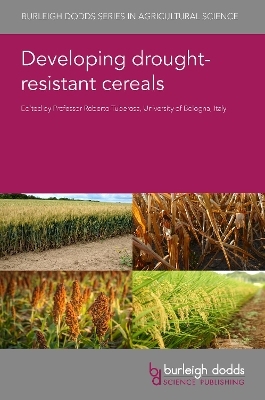
Developing Drought-Resistant Cereals
Burleigh Dodds Science Publishing Limited (Verlag)
978-1-78676-985-5 (ISBN)
Drought remains the biggest single threat from climate change to the production of key cereal crops, such as wheat and barley. Cereals also respond in complex ways to drought stress, making improved drought tolerance a challenging trait to achieve. With many cereals recognised as staple food crops due to their nutritional value, more research is required into improving drought tolerance as a means of ensuring the future food security of millions.
Developing drought-resistant cereals reviews the wealth of research which addresses how to overcome this challenge in order to mitigate climate change effects in cereal production. This collection details our understanding of the mechanisms of drought tolerance, as well as the development of techniques for improving resistance, including phenotyping, genome-wide association studies (GWAS) and genome editing.
Dr Roberto Tuberosa is Professor of Plant Biotechnology and Breeding in the Department of Agriculture and Food Science at the University of Bologna, Italy. Professor Tuberosa is internationally renowned for his genomic studies to dissect the genetic basis of drought resistance in cereals and how to leverage this knowledge toward the release of climate-resilient cultivars. He is on the editorial board of several leading journals, has been involved in many European and international research projects in cereal breeding, represents Europe in the International Crop Science Society (ICSS) and has published over 170 articles as well as edited a number of books. Amongst other honours, Professor Tuberosa has been elected a Fellow of the Crop Society of America. Bill Davies is Emeritus Distinguished Professor of Plant Biology at Lancaster University, UK. He has published more than 280 papers in the international literature. The Davies lab has won a ‘Queen’s Award for Innovation’ for work on sustainable resource use in agriculture. Recent work with CIMMYT has resulted in the development of new pre-breeding crop screening methods. Professor Davies is currently an Associate Editor of 'Food and Energy Security' and 'Frontiers of Agricultural Science and Engineering'. He was awarded a CBE for his services for science in 2011. John C. Cushman is a Foundation Professor at the University of Nevada and Director of the Biochemistry Graduate Program in the Department of Biochemistry & Molecular Biology within the College of Agriculture, Biotechnology, and Natural Resources and the Nevada Agricultural Experiment Station. Professor Cushman's laboratory has used engineered tissue succulence and crassulacean acid metabolism (CAM) to improve the water-use efficiency, salinity, and water-deficit stress tolerance in model plant species with the long-term goal of moving these water-conserving adaptations into food, feed, and (bio)fuel crops enabling production on marginal or abandoned agricultural lands. A major focus of his laboratory is to investigate the productivity and irrigation response of highly productive CAM crops such as cactus pear (Opuntia spp.) to serve as sources of human food, animal feed, and as a biofuel feedstock for semi-arid and arid regions of the world.
Part 1 Understanding mechanisms of drought tolerance
1.Physiological traits affecting water use and water use efficiency in cereals in response to drought stress: Thomas R. Sinclair, North Carolina State University, USA; and Michel E. Ghanem, Centre de coopération internationale en recherche agronomique pour le développement (CIRAD), France and Mohammed VI Polytechnic University, Morocco;
2.The role of plant hormones in adaptation to drought stress in cereals: Arnauld A. Thiry, Lancaster Environment Centre, UK; Matthew P. Reynolds, International Maize and Wheat Improvement Center (CIMMYT), Mexico; and William J. Davies and Ian C. Dodd, Lancaster Environment Centre, UK;
3.The role of drought stress-induced proteins in regulating drought resistance in cereals: John Cushman, University of Nevada-Reno, USA;
Part 2 Techniques for improving resistance
4.Identifying and exploiting drought tolerance traits in wild cereals, varieties and landraces: Zvi Peleg, Hebrew University of Jerusalem, Israel;
5.Advances in phenotyping to identify drought-resistance traits in cereal roots: Jack Christopher, University of Queensland, Australia;
6.Advanced genetic techniques to identify and evaluate drought-adaptive loci in cereals: Roberto Tuberosa, University of Bologna, Italy;
7.Identifying and exploiting genes related to root system architecture in improving drought resistance in cereals: Eric Ober, NIAB, UK;
8.Identifying and exploiting photosynthetic genes in improving drought resistance in cereals: Ruilian Jing, Chinese Academy of Agricultural Sciences, China;
9.Genomic selection, gene editing and genetic engineering for drought tolerance in cereals: Rodomiro Ortiz, Swedish University of Agricultural Sciences (SLU), Sweden;
| Erscheinungsdatum | 23.12.2023 |
|---|---|
| Reihe/Serie | Burleigh Dodds Series in Agricultural Science ; 124 |
| Co-Autor | Professor Tom Sinclair, Dr Michel E. Ghanem, Dr Arnauld A. Thiry, Dr Matthew P. Reynolds |
| Zusatzinfo | Color tables, photos and figures |
| Verlagsort | Cambridge |
| Sprache | englisch |
| Maße | 152 x 229 mm |
| Themenwelt | Weitere Fachgebiete ► Land- / Forstwirtschaft / Fischerei |
| ISBN-10 | 1-78676-985-9 / 1786769859 |
| ISBN-13 | 978-1-78676-985-5 / 9781786769855 |
| Zustand | Neuware |
| Haben Sie eine Frage zum Produkt? |
aus dem Bereich


